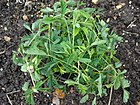Note: This is a project under development. The articles on this wiki are just being initiated and broadly incomplete. You can Help creating new pages.
Difference between revisions of "Mimosa pudica - Lajjika"
(→References) |
(→List of Ayurvedic medicine in which the herb is used) |
||
| Line 46: | Line 46: | ||
==List of Ayurvedic medicine in which the herb is used== | ==List of Ayurvedic medicine in which the herb is used== | ||
| − | + | [[Kutajavaleha]], [[Samangadi churna]], [[Lakshadi churna]]<ref name="Ayurvedic preparations"/> | |
| − | |||
| − | |||
| − | <ref name="Ayurvedic preparations"/> | ||
==Where to get the saplings== | ==Where to get the saplings== | ||
Revision as of 12:25, 9 January 2024
Lajjika is an annual to perennial, more or less prostrate creeping plant. The plant can grow up to 1 metre tall. The plant is gathered from the wild for local medicinal use. It is cultivated as a green manure and for soil stabilization and is sometimes also cultivated for its uses in folk medicine. Probably arose in the Neotropics, but now Pantropical.
Contents
- 1 Uses
- 2 Parts Used
- 3 Chemical Composition
- 4 Common names
- 5 Properties
- 6 Habit
- 7 Identification
- 8 List of Ayurvedic medicine in which the herb is used
- 9 Where to get the saplings
- 10 Mode of Propagation
- 11 How to plant/cultivate
- 12 Commonly seen growing in areas
- 13 Photo Gallery
- 14 References
- 15 External Links
Uses
Female reproductive disorders, Diarrhea, Bleeding disorders, Ulcers, Inflammation, Gastritis, Fatigue, Asthma, Skin diseases.[1]
Parts Used
Chemical Composition
Mimosa pudica contains various compounds, including "alkaloids, flavonoid C-glycosides, sterols, terenoids, tannins, saponin and fatty acids". The roots of the plant have been shown to contain up to 10% tannin etc.[3]
Common names
| Language | Common name |
|---|---|
| Kannada | Naachike gida, Naachike mullu |
| Hindi | Chui mui, Lajalu |
| Malayalam | Thendarmani, Thotavadi |
| Tamil | Alavananki |
| Telugu | Atthapatthi, Lajjavanthi |
| Marathi | NA |
| Gujarathi | NA |
| Punjabi | NA |
| Kashmiri | NA |
| Sanskrit | Ajalikalika, Alambusa |
| English | Sensitive plant |
Properties
Reference: Dravya - Substance, Rasa - Taste, Guna - Qualities, Veerya - Potency, Vipaka - Post-digesion effect, Karma - Pharmacological activity, Prabhava - Therepeutics.
Dravya
Rasa
Tikta (Bitter), Kashaya (Pungent)
Guna
Laghu (Light), Rooksha (Dry)
Veerya
Sheeta (cold)
Vipaka
Katu (Pungent)
Karma
Pitta, Kapha
Prabhava
Habit
Identification
Leaf
| Kind | Shape | Feature |
|---|---|---|
| Bipinnate | Alternate | Borne on stalks (i.e. petioles) 15-60 mm long. They consist of one or two pairs of branchlets (i.e. pinnae) that often have a covering of stiff, prickly, bristles. |
Flower
| Type | Size | Color and composition | Stamen | More information |
|---|---|---|---|---|
| Bisexual | Axillary | Pink | 4 | The pink or purplish coloured flowers are arranged in small, fluffy, globular or egg-shaped (i.e. ovoid) clusters (9-15 mm across). Flowering from August to April |
Fruit
| Type | Size | Mass | Appearance | Seeds | More information |
|---|---|---|---|---|---|
| A Pod | 10-25 mm long and 3-6 mm wide | The oblong and flattened seed pods are borne in clusters at the ends of the flowering stalks. | Fruiting from August to April |
Other features
List of Ayurvedic medicine in which the herb is used
Kutajavaleha, Samangadi churna, Lakshadi churna[6]
Where to get the saplings
Mode of Propagation
How to plant/cultivate
Seed - it has a hard seedcoat and may benefit from scarification before sowing to speed up germination.[7]
Commonly seen growing in areas
Tropical area, Sub tropical area
Photo Gallery
References
- ↑ Uses
- ↑ ”Karnataka Medicinal Plants Volume-3” by Dr.M. R. Gurudeva, Page No.1076, Published by Divyachandra Prakashana, #6/7, Kaalika Soudha, Balepete cross, Bengaluru
- ↑ Chemical composition
- ↑ Vernacular names
- ↑ Botonic description
- ↑ Ayurvedic preparations
- ↑ Cultivation details
External Links
- Ayurvedic Herbs known to be helpful to treat Female reproductive disorders
- Ayurvedic Herbs known to be helpful to treat Diarrhea
- Ayurvedic Herbs known to be helpful to treat Bleeding disorders
- Ayurvedic Herbs known to be helpful to treat Ulcers
- Ayurvedic Herbs known to be helpful to treat Inflammation
- Ayurvedic Herbs known to be helpful to treat Gastritis
- Ayurvedic Herbs known to be helpful to treat Fatigue
- Ayurvedic Herbs known to be helpful to treat Asthma
- Ayurvedic Herbs known to be helpful to treat Skin diseases
- Herbs with Whole plant used in medicine
- Herbs with Root used in medicine
- Herbs with Leaf used in medicine
- Herbs with common name in Kannada
- Herbs with common name in Hindi
- Herbs with common name in Malayalam
- Herbs with common name in Tamil
- Herbs with common name in Telugu
- Herbs with common name in Sanskrit
- Herbs with common name in English
- Habit - Herb
- Index of Plants which can be propagated by Seeds
- Herbs that are commonly seen in the region of Tropical area
- Herbs that are commonly seen in the region of Sub tropical area
- Herbs
- Herb
- Ayurvedic herbs that don't have seed photos
- Fabaceae





